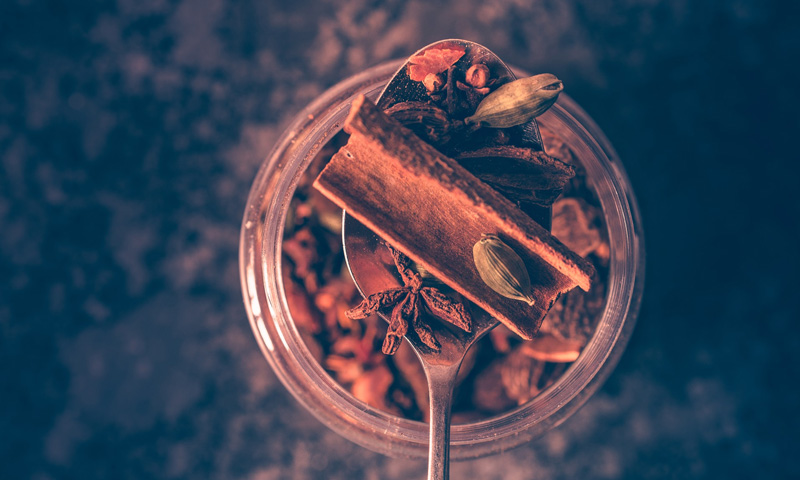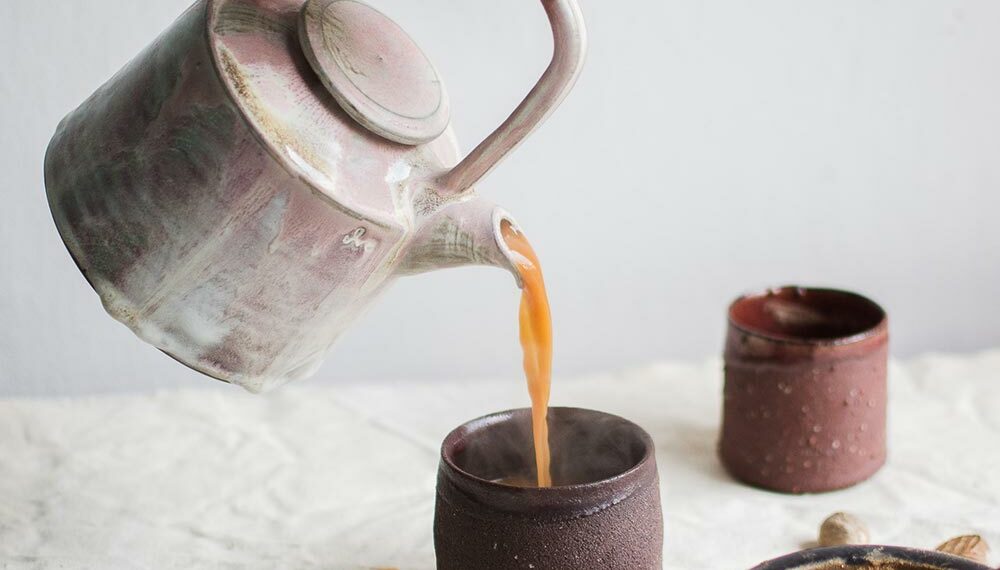Yogi Tea: How to Make It & Why It Is Good for You
Yogi tea is made with black pepper, cardamom, cloves, cinnamon and a bit of ginger. Thanks to their antioxidant and anti-inflammatory compounds, it is said to be especially helpful in protecting you against the flu and the cold. Each spice also has its own health-related superpowers – from boosting the immune system, lowering blood pressure and blood sugar levels to helping to prevent cancer.
Before we get into how to make yogi tea, let’s dive deeper into the health benefits of each ingredient!

The Spices in Yogi Tea: Health Benefits Backed by Science and According to Ayurveda
Cardamom, black pepper, cloves and cinnamon have been used in Ayurveda for centuries. But not only ancient Indian tradition and scriptures suggest the immense health benefits of these spices, also modern science is backing them up.
Many of these studies have been conducted on rats and surely there is more research on the effect of spices on humans is necessary, but the results so far, many confirming what Ayurveda has known all along, are very promising!
Black Peppercorns – Everything but Ordinary
You might use pepper every day while cooking, but it can do much more than just giving your dishes a little more spice!
Pepper’s component piperine is high in antioxidants. They catch all those bad free radicals in your body which can damage your cells and lead to serious health problems like heart diseases or cancer.
Piperine’s anti-inflamatory effect may help with arthritis, asthma and many other health issues. It may also help fight cancer, lower cholesterol and improve the brain function, helping fight diseases like Althzheimers.
Pepper also helps the body to absorb certain nutrients and components in other spices better, the best example here being turmeric.
In Ayurveda black pepper is categorized as a warming spice with a pungent taste. It helps pacifying an overactive Kapha or Vata dosha (more info about the three doshas here), but increases the Pitta dosha. It is said to be excellent when you suffer from a cough or a cold.
Cardamom – The Queen of Spices
Cardamom has a very intensive taste and is one of the world’s most expensive spices, but considering all its health benefits, it is definitely worth the money!
Like pepper it is rich in antioxidants and has anti-inflammatory properties.
It increases the activity of cancer-fighting enzymes and so may help fight cancer. Additionally, Cardamom may lower blood pressure, may be good for digestion, may heal ulcers and might even be able to protect your teeth from cavities.
According to Ayurveda cardamom has warming as well as calming qualities and it helps to balance the three doshas. It is said to also remove mucus from the lungs and the stomach and to help treat fever. Its calming qualities help ease anxiety and to relax the muscles.
Cloves – The Smell of Christmas
While we use cloves mainly around Christmas it is a staple in Indian cuisine all year round. Considering all the good it can do for our bodies, we should definitely follow suit!
In cloves, too, we find our friendly antioxidants, catching free radicals and helping protect us from many chronic diseases.
The antimicrobial properties of cloves may particularly support your oral health. It is also rich in manganese, which makes bones strong and is good for the brain.
Additionally, cloves may help with insulin production, lowering the blood sugar level in the process, and heal ulcers.
According to Ayurveda, cloves can help to control the Kapha dosha and to balance all three doshas. They are said to additionally be an effective remedy for cold and flu as well as to improve digestion.
Cinnamon – More Than Just a Tree Bark
Cinnamon is a spice obtained from the bark of trees from the genus Cinnamomum. Who would have thought that tree bark can taste so delicious and be so healthy?
This special tree bark is, like all other ingredients of this tea, rich in antioxidants and anti-inflammatory components.It may reduce the risk of heart disease and help regulate blood sugar.
Cinnamon’s antibacterial properties may help reduce infections and improve oral health.
Cinnamon may even protect from cancer and help with the symptoms of Alzheimers and Parkinson.
According to Ayurveda it pacifies the Vata and Kapha dosha, but increases Pitta. It is said to additionally support digestion and liver function, but also to be a remedy for the symptoms of cold and flu. As a cherry on the cake, it is also said to be good for your skin.
Ginger – A Rhizome with Many Talents
One of the key spices of Indian cuisine, Ginger, doesn’t only taste good, but also does a lot of good things for your body. For a change, we have here several studies on the health benefits of ginger, which were conducted on humans and not on rats.
Ginger is a real all-rounder, full of anti-inflammatory compounds and antioxidants. It may help against nausea, reduce muscle pain and soreness and it may help to lower blood pressure, cholesterol levels as well as reduce the risk for heat disease.
Additionally, it is soothing for the nerves, may help with indigestion, reduce menstrual pain, it even may help prevent cancer and age related damage to the brain.
Last but not least, it may help you fight off various bacteria and viruses, decreasing your risk for annoying infections like the common cold
According to Ayurveda ginger has cold and dry qualities and helps you additionally to everything mentioned above absorb nutrients more effectively.
Honey – Liquid Gold
Since mesolithic times humans have been risking painful stings while collecting this golden, nutritious syrup and it has been used in folk medicine ever since. Luckily, also for honey we can back up our science with human trials.
Honey is rich in antioxidants, which may help prevent cancer, lower blood pressure und prevent heart attacks. Some of honey’s other compounds may reduce the risk for heart diseases. Applied externally on wounds, it may work as antiseptic and support the healing process. Lastly, it is a deliciously tasting cough suppressant.
Ayurveda considers honey as one of the most powerful ingredients there is. Besides all the above mentioned benefits, it is also said to help cure insomnia.
You can see, that by drinking yogi tea regularly, have your health covered. From preventing infections, lowering blood pressure and blood sugar to being good for your brain and helping prevent cancer – a few cups of yogi tea a day (hopefully) keep the doctor away.
How to Make Yogi Tea
To get the maximal health benefits out of your yogi tea, it is important to use high quality ingredients. Definitely try not to use cheap honey (which is not much more than artificial sugar syrup), but use real, good quality honey from happy bees.
After trying the recipe for the first time feel free to play around with the ingredients and adjust the tea to your taste. If you really like the taste of cinnamon, add an additional stick, if you love cardamom, throw in a few additional pods.
If you don’t want to use any sweetener, you can also just make the tea without the honey. The same goes for the milk, you can add a few splashes or just enjoy the tea without. It all comes down to your personal preference.
It is important to use the whole form of the spices. The ground form would give the tea a rather unpleasant texture.
We recommend to make a big batch of yogi tea and to drink it throughout the day (either cold or you can quickly heat it up again).
For 1 liter you need approximately:
8 cloves
10 crushed cardamom pods
1-2 cinnamon sticks
10 black peppercorns
4 slices ginger
1 tsp black tea
Honey (optional)
Milk (optional)
- Put a pot with water on the stove and bring to a boil.
- Add all the spices, except the ginger.
- Let boil on low heat for about 15 minutes, then add the ginger and boil for further 10-15 minutes.
- Add the black tea and, depending on how strong you want your yogi tea to be, let it steep for a few minutes.
- Pour the yogi tea through a strainer into a teapot or another big container.
- If you want to, add a few splashes of milk right before drinking.
Leave the tea on the kitchen counter or on your desk, so you can pour yourself a cup whenever you want to. Enjoy the tea with a book, while you work or after your yoga practice in one of Budapest’s best yoga studios.
 English
English magyar
magyar